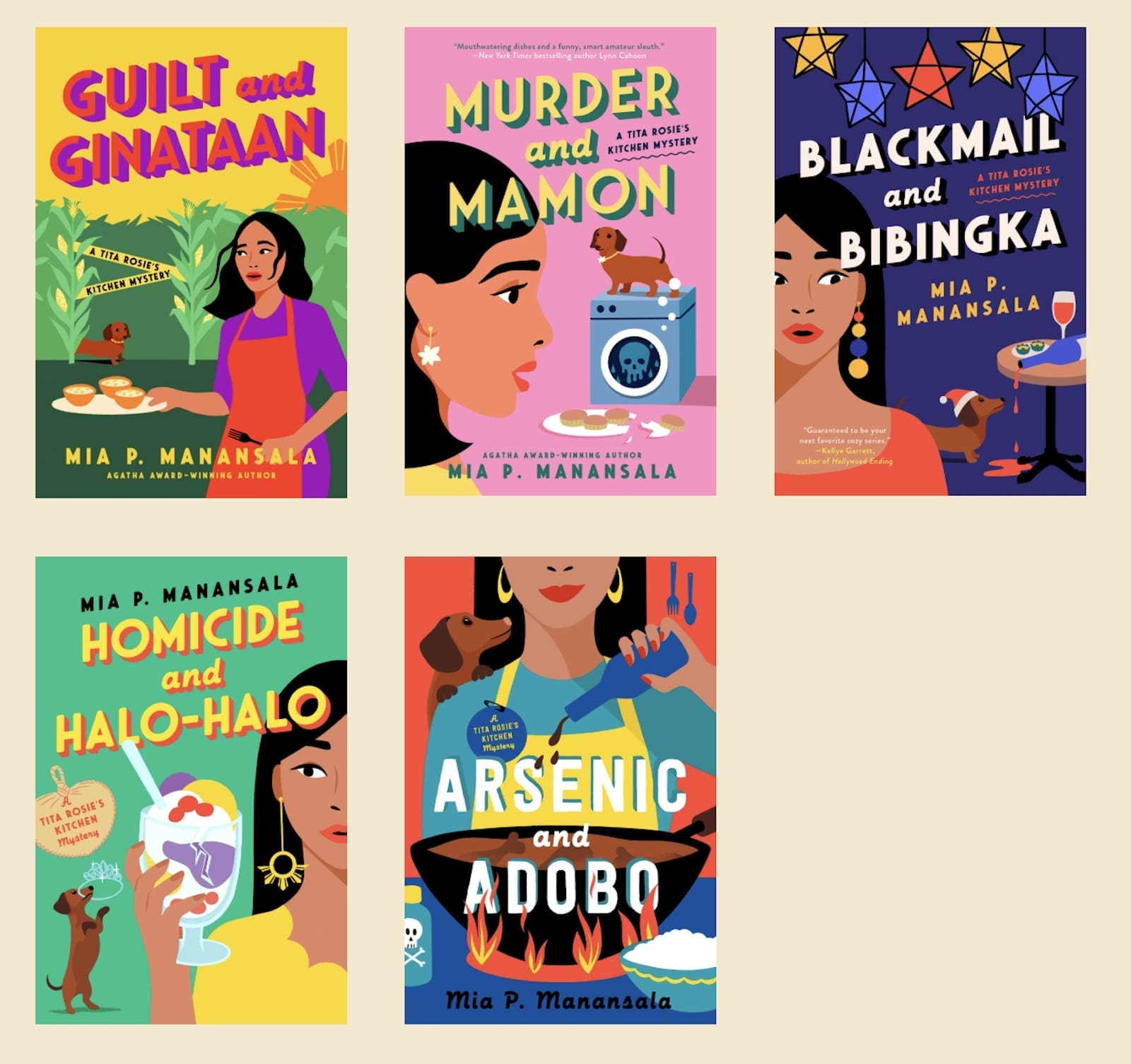There is a joyful, almost fanatical, tone to Mia P. Manansala when she speaks and writes about food. The author of Tita Rosie’s Kitchen Mystery series keeps each culinary gem stored safely in a dedicated Google Doc — whether it’s a Filipino dish she saw on Instagram, meals from the many restaurants in Chicago, her home city, or recipes she grew up eating in her multi-generational Filipino family. “A plate of food is never just a plate of food, both in real life or on the page,” says Manansala after describing in length her father’s kare-kare and sinigang recipes. “There are strings attached, for better or worse.”
For Manansala, it was only natural that she’d place food — particularly Filipino food — center stage in her five cozy mystery novels, all of which comprise the Tita Rosie’s series. The first novel, Arsenic and Adobo, was released in 2021 and revolves around the series protagonist Lila Macapagal who, after moving back home to save her Tita Rosie’s failing restaurant, must solve the case of a murdered food critic/ex-boyfriend. Since then, Manansala’s work has been met with high praise from fans and critics alike. Arsenic and Adobo went on to win multiple awards, pushing Manansala into the literary spotlight.
The proceeding novels — Homicide and Halo-Halo, Blackmail and Bibingka, Murder and Mamon, and the latest Guilt and Ginataan — all carry the same familiar blend of crime, family, and most importantly, food. When asked about her playful and Pinoy-centric titles, Manansala laughs as if the answer were obvious. “I want people to see that Filipino food is more than lumpia, right?” Manansala says. “We don’t only have pancit. It’s an archipelago, there are so many varieties.”

This desire to showcase her Filipino culinary heritage shines through in Manansala’s writing. While all five novels switch back and forth between crime scenes, amateur detective work, and moments of light-hearted (if, at times, cheesy) comedy, Manansala always ensures that food is in the foreground of her story. Guilt and Ginataan opens with Lila and her friends setting up a food stall at the local corn festival. Manansala puts readers in awe as she describes ginataang mais latte, mais ube sandwich cookies, mais kon keso bars, and mais kon yelo. Even recipes from other cultures, such as Mexican elotes and Korean oksusu cha (corn tea), are infused with Filipino twists. Manansala delights in showing variations on Filipino cuisine, finding ways to include experiments like vegan sisig and calamansi chia seed muffins into scenes of intrigue, mystery, and murder.
Manansala attributes her deep connection with food to her father and how he was the cook of the family. “On the weekends when my father didn’t have to work long hours at a factory, he and my grandmother would wake up early,” says Manansala. “They would go to the Asian markets of Chicago and get the best produce they could find. He would cook a lot during the weekends. That was his way of showing care. He [would be]really tired from work, but this was important to him — to feed his family on the weekend.”
The dishes that Manansala’s father cooked for the family are what tethered the young author to her Filipino identity. “For many of us [diaspora] kids,” explains Manansala, “food is that one tangible connection we have. That’s how I [learned] about my identity and community, through the food.” To Manansala, distinct ideas such as food, family, and identity are unquestionably interwoven with one another, so all three must be honored in her writing. The pivotal moments in Manansala’s novels happen around a crowded dinner table, creating this image of a family supporting each other as they eat and discuss the next step in catching the villain. “Lila’s an amateur sleuth,” says Manansala when describing her main character. “Which means she’s not a professional. She’s a cookie baker. But she’s not alone. She has this wide network she can turn to, and these people all have her back, and she knows she can rely on them. That, in my mind, is very Filipino.”

While Manansala is now widely popular — partly because of the cultural representation in her novels — the writer admits that she saw racial bias, discrimination, and rejection early on in her career. Her first finished novel, centered around a queer Filipino-American millennial solving a mystery at a comic book convention, was met with constant rejection from publishers.
“Some of them literally said in the rejection letter said traditional mystery is for older white women, and that I didn’t have an audience,” reveals Manansala. Now, despite early rejections, Manansala has a multi-book series deal with her publisher, Berkley/Penguin Random House. “[They] missed out,” says Manansala when asked about what she thinks of those early prospective publishers. “I knew there were people who were hungry for [my] kind of stories and they couldn’t find them.” As a way of supporting those who may be facing the same obstacles she did at the start of her career, Manansala advocates for budding writers as a book coach and member of Crime Writers of Color, an organization of writers striving to create a community for crime/mystery writers from traditionally underrepresented backgrounds.
As a writer, Manansala continues to push the boundaries of the cozy mystery genre. Her next novel, Death and Dinuguan, is set to release next year, along with her first dip into young adult fiction, Death in the Cards.
“None of us are monoliths,” says Manansala. “I am writing about people who are fully human in many ways. I give [my characters] layers and layers — like take me, [for example], right? I’m Filipino and I’m also queer and I’m also… I am so many ands.”





